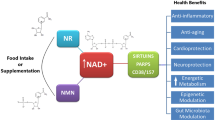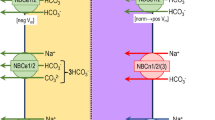Abstract
Purpose
Prodrugs with pivalic acid and valproic acid decrease l-carnitine concentration in plasma and tissues by urinary excretion of acylcarnitine as pivaloylcarnitine (PC) and valproylcarnitine (VC), respectively. We investigated the role of the Na+/l-carnitine cotransporter in the porcine kidney epithelial cell line, LLC-PK1 for the decrease of l-carnitine concentration.
Methods
The uptake of l-[3H]carnitine, acetyl-l-[3H]carnitine (AC), l-[3H]PC and l-[3H]VC were investigated in LLC-PK1 cells seeded in a 6-well culture plate.
Results
l-Carnitine and AC uptake in LLC-PK1 cells exhibited Na+ dependency. The K m values for l-carnitine and AC uptake were 11.0 and 8.18 μM, respectively. These results indicated expression of Na+/l-carnitine cotransporter in LLC-PK1 cells. PC and VC inhibited Na+/l-carnitine cotransporter in the competitive (K i = 90.4 μM) and noncompetitive (K i = 41.6 μM) manners, respectively. PC and VC uptake by Na+/l-carnitine cotransporter were not observed in LLC-PK1 cells.
Conclusions
These data suggested that PC and VC formed in the body could not be reabsorbed in the kidney, resulting in the decrease of l-carnitine concentration. In addition, inhibition of l-carnitine reabsorption by VC with lower K i value could induce the decrease of l-carnitine concentration. Collectively, the recognition and interaction of Na+/l-carnitine cotransporter are important factors for carnitine homeostasis.






Similar content being viewed by others
Abbreviations
- AC:
-
acetyl-l-carnitine
- PC:
-
pivaloylcarnitine
- VC:
-
valproylcarnitine
References
L. L. Bieber. Carnitine. Ann. Rev. Biochem. 57:261–283 (1988).
C. J. Rebouche, and D. L. Mack. Sodium gradient-stimulated transport of l-carnitine into brush border membrane vesicles: kinetics, specificity, and regulation by dietary carnitine. Arch. Biochem. Biophys. 235:393–402 (1984).
B. Stieger, B. O'Neill, and S. Krähenbühl. Characterization of l-carnitine transport by rat kidney brush-border-membrane vesicles. Biochem. J. 309:643–647 (1995).
A. Marzo, A. E. Martelli, A. Mancinelli, G. Cardace, C. Corbelletta, E. Bassani, and M. Solbiati. Protein binding of l-carnitine family components. Eur. J. Drug Metab. Pharmacokinet. 3:364–368 (1991).
I. Tamai, R. Ohashi, J. Nezu, H. Yabuuchi, A. Oku, M. Shimane, Y. Sai, and A. Tsuji. Molecular and functional identification of sodium ion-dependent, high affinity human catnitine transporter OCTN2. J. Biol. Chem. 273:20378–20382 (1998).
X. Wu, P. D. Prasad, F. H. Leibach, and V. Ganapathy. cDNA sequence, transport function, and genomic organization of human OCTN2, a new member of the organic cation transporter family. Biochem. Biophys. Res. Commun. 246:589–595 (1998).
J. Nezu, I. Tamai, A. Oku, R. Ohashi, H. Yabuuchi, N. Hashimoto, H. Nikaido, Y. Sai, A. Koizumi, Y. Shoji, G. Takada, T. Matsuishi, M. Yoshino, H. Kato, T. Ohura, G. Tsujimoto, J. Hayakawa, M. Shimane, and A. Tsuji. Primary systemic carnitine deficiency is caused by mutations in a gene encoding sodium ion-dependent carnitine transporter. Nat. Genet. 21:91–94 (1999).
Y. Wang, J. Ye, V. Ganapathy and N. Longo. Mutations in the organic cation/carnitine transporter OCTN2 in primary carnitine deficiency. Proc. Natl. Acad. Sci. USA 96:2356–2360 (1999).
C. J. Rebouche. Carnitine metabolism and its regulation in microorganisms and mammals. Annu. Rev. Nutr. 18:39–61 (1998).
A. Marzo, E. Arrigoni Martelli, R. Urso, M. Rocchetti, V. Rizza, and J. G. Kelly. Metabolism and disposition of intravenously administered acetyl-l-carnitine in healthy volunteers. Eur. J. Clin. Pharmacol. 37:59–63 (1989).
A. Mancinelli, A. Longo, K. Shanahan, and A. M. Evans. Disposition of l-carnitine and acetyl-l-carnitine in the isolated perfused rat kidney. J. Pharmacol. Exp. Ther. 274:1122–1128 (1995).
R. Ohashi, I. Tamai, H. Yabuuchi, J. Nezu, A. Oku, Y. Sai, M. Shimane, and A. Tsuji. Na+-dependent carnitine transport by organic cation transporter (OCTN2): its pharmacological and toxicological relevance. J. Pharmacol. Exp. Ther. 291:778–784 (1999).
E. P. Brass, M. D. Mayer, D. J. Mulford, T. K. Stickler, and C. L. Hoppel. Impact on carnitine homeostasis of short-term treatment with the pivalate prodrug cefditoren pivoxil. Clin. Pharmacol. Ther. 73:338–347 (2003).
E. Holme, J. Greter, C. E. Jacobson, S. Lindstedt, I. Nordin, B. Kristiansson, and U. Jodal. Carnitine deficiency induced by pivampicillin and pivmecillinam therapy. Lancet 2:469–473 (1989).
B. Melegh, J. Kerner, and L. L. Bieber. Pivampicillin-promoted excretion of pivaloylcarnitine in humans. Biochem. Pharmacol. 36:3405–3409 (1987).
K. Shimizu, A. Saito, J. Shimada, M. Ohmichi, Y. Hiraga, T. Inamatsu, K. Shimada, M. Tanimura, Y. Fujita, T. Nishikawa, T. Oguma, and S. Yamamoto. Carnitine status and safety after administration of S-1108, a new oral cephem, to patients. Antimicrob. Agents Chemother. 37:1043–1049 (1993).
T. Kanazu, and T. Yamaguchi. Comparison of in vitro carnitine and glycine conjugation with branched-side chain and cyclic side chain carboxylic acids in rats. Drug Metab. Dispos. 25:149–153 (1997).
K. Mizojiri, S. Futaguchi, R. Norikura, Y. Katsuyama, T. Nagasaki, T. Yoshimori, and N. Nakanishi. Disposition of S-1108, a new oral cephem antibiotic, and metabolic fate of pivalic acid liberated from [pivaloyl-14C]S-1108 in rats and dogs. Antimicrob. Agents Chemother. 39:1445–1453 (1995).
K. Totsuka, K. Shimizu, M. Konishi, and S. Yamamoto. Metabolism of S-1108, a new oral cephem antibiotic, and metabolic profiles of its metabolites in humans. Antimicrob. Agents Chemother. 36:757–761 (1992).
D. S. Millington, T. P. Bohan, C. R. Roe, A. L. Yergey, and D. J. Liberato. Valproylcarnitine: a novel drug metabolite identified by fast atom bombardment and thermospray liquid chromatography-mass spectrometry. Clin. Chim. Acta 145:69–76 (1985).
Y. Ohtani, F. Endo, and I. Matsuda. Carnitine deficiency and hyperammonemia associated with valproic acid therapy. J. Pediatr. 101:782–785 (1982).
J. P. Van Wouwe. Carnitine deficiency during valproic acid treatment. Int. J. Vitam. Nutr. Res. 65:211–214 (1995).
K. Inui, H. Saito, and R. Hori. H+-gradient-dependent active transport of tetraethylammonium cation in apical-membrane vesicles isolated from kidney epithelial cell line LLC-PK1. Biochem. J. 277:199–203 (1985).
H. Saito, M. Yamamoto, K. Inui, and R. Hori. Transcellular transport of organic cation across monolayers of kidney epithelial cell line LLC-PK1. Am. J. Physiol. 262:C59–C66 (1992).
S. Ohnishi, H. Saito, A. Fukada, and K. Inui. Independent organic cation transport activity of Na+-l-carnitine cotransport system in LLC-PK1 cells. Am. J. Physiol. 281:F273–F279 (2001).
O. H. Lowry, N. J. Rosebrough, A. L. Farr, and R. J. Randall. Protein measurement with the Folin phenol reagent. J. Biol. Chem. 193: 265–275 (1951).
B. Melegh, J. Kerner, G. Kispal, G. Acsadi, and M. Dani. Effect of chronic valproic acid treatment on plasma and urine carnitine levels in children: decreased urinary excretion. Acta Pediatr. Hung. 28:137–142 (1987).
B. Melegh, J. Kerner, V. Jaszai, and L. L. Bieber. Differential excretion of xenobiotic acyl-esters of carnitine due to administration of pivampicillin and valproate. Biochem. Med. Metab. Biol. 43:30–38 (1990).
I. Tein, S. DiMauro, Z. W. Xie, and D. C. De Vivo. Valproic acid impairs carnitine uptake in cultured human skin fibroblasts. An in vitro model for the pathogenesis of valproic acid-associated carnitine deficiency. Pediatr. Res. 34:281–287 (1993).
P. Molstad, T. Bohmer, and K. Eiklid. Specificity and characteristics of the carnitine transport in human heart cells (CCL 27) in culture. Biochim. Biophys. Acta. 471:296–304 (1977).
J. Li, D. L. Norwood, L. F. Mao, and H. Schulz. Mitochondrial metabolism of valproic acid. Biochemistry 30:388–394 (1991).
T. Sugimoto, H. Muro, M. Woo, N. Nishida, and K. Murakami. Valproate metabolites in high-dose valproate plus phenytoin therapy. Epilepsia 12:1200–1203 (1996).
Acknowledgments
We cordially thank Yoshihiko Katsuyama and Katsunori Sakai in Shionogi & Co., Ltd. for synthesizing the labeled and unlabeled compounds.
Author information
Authors and Affiliations
Corresponding author
Rights and permissions
About this article
Cite this article
Okamura, N., Ohnishi, S., Shimaoka, H. et al. Involvement of Recognition and Interaction of Carnitine Transporter in the Decrease of l-Carnitine Concentration Induced by Pivalic Acid and Valproic Acid. Pharm Res 23, 1729–1735 (2006). https://doi.org/10.1007/s11095-006-9002-9
Received:
Accepted:
Published:
Issue Date:
DOI: https://doi.org/10.1007/s11095-006-9002-9




